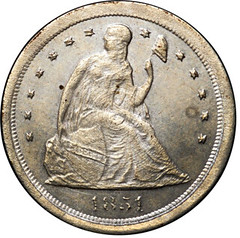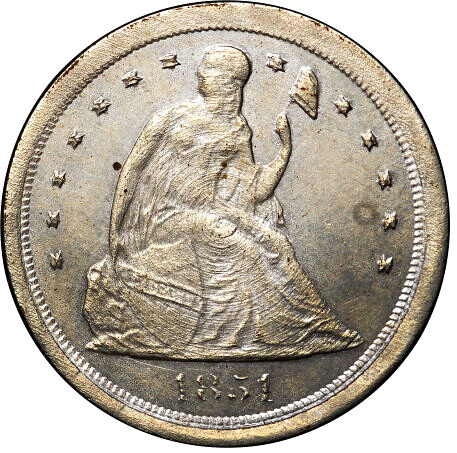
PREV ARTICLE
NEXT ARTICLE
FULL ISSUE
PREV FULL ISSUE
THE PORTRAIT LATHE AND A LIBERTY SEATED CENT PATTERN
Another core coining technology collectors should be aware of is the portrait lathe. Len Augsburger's column in the May 2013 issue of the E-Gobrecht describes an interesting pattern coin which exhibits evidence of portrait lathe markings: a Liberty Seated Cent.
-Editor


A Liberty Seated cent? Yes, Virginia, there is such a thing. In 1853, the Mint got the idea that different compositions might be used for large cents, and that perhaps the large, heavy coppers could be replaced with something more manageable. The Mint began experimenting with German silver, a combination of copper, nickel, and zinc. The alloy has a passable resemblance to silver, but in reality contains no silver at all. Pattern cents were produced in 1853 and 1854 with varying percentages of copper, nickel and zinc. The 1854 edition is the one of interest to Liberty Seated collectors. The obverse for this pattern was created by reducing an 1854 seated dollar via portrait lathe. The portrait lathe traced the 1854 dollar with a stylus moving in a circular fashion around the coin. This design was then transferred onto the pattern cent die, with the circular lathe lines imparted as well. In practice, the lathe lines would be polished out on the die, leaving no trace of the reproduction. In this particular case, the Mint was more interested in trying out different alloys, and in haste neglected the polishing. Even on modern coinage, lathe lines are sometimes seen - I have a 1996-D Lincoln cent pulled out of circulation which demonstrates the effect, although to be sure it is much less pronounced than on the 1854 cent pattern. Among Liberty Seated coinage, the Scott Confederate half dollar restrikes (executed in 1879 using 1861 half dollars) frequently come with evidence of lathe lines, although this is thought to have occurred when Scott ground off the reverses of the coins before restriking them with his own reverse (which was a reproduction of the Confederate half dollar). Back to the 1854 cent, these of course never caught on, and the Mint decided that a smaller format piece in copper would work just as well, and so the 1856 flying eagle cents were born shortly thereafter. To be sure, the coinage was debased, with a smaller amount of metal representing the same face value - governments are good at such things - the Liberty Seated silver coinage, in 1853, had of course also been reduced in weight. Nevertheless, the German silver experiments of 1853 and 1854 leave us with a curiosity in the Liberty Seated series, a coin that tells a story about the technical production of the Mint in mid-19th century.
The E-Gobrecht is the electronic newsletter of the Liberty Seated Collectors Club, and the May 2013 issue is #100! Congratulations! And here's a larger image of the coin, where the circular markings are readily apparent.
-Editor

For more information on the Liberty Seated Collectors Club, see:
www.lsccweb.org
The Numismatic Bibliomania Society is a non-profit organization promoting numismatic literature. See our web site at coinbooks.org. To submit items for publication in The E-Sylum, write to the Editor at this address: whomren@gmail.com To subscribe go to: https://my.binhost.com/lists/listinfo/esylum All Rights Reserved. NBS Home Page Contact the NBS webmaster 
|